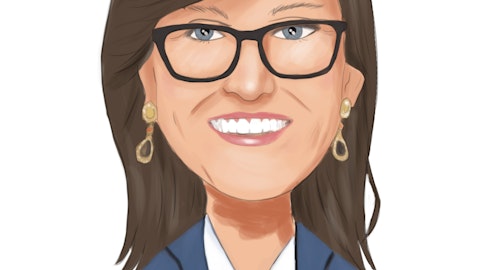CME Group Inc. (NASDAQ:CME) Q4 2022 Earnings Call Transcript February 8, 2023
Operator: Greetings and welcome to the CME Group Fourth Quarter and Year End 2022 Earnings Call. As a reminder, this conference is being recorded, Wednesday, February 8, 2023. I would now like to turn the conference over to Adam Minick. Please go ahead.
Adam Minick: Good morning and I hope you are all doing well today. We will be discussing CME Group’s fourth quarter and full year 2022 financial results. I will start with the Safe Harbor language, then I will turn it over to Terry and team for brief remarks followed by your questions. Other members of our management team will also participate in the Q&A session. Statements made on this call and in the other reference documents on our website that are not historical facts are forward-looking statements. These statements are not guarantees of future performance. They involve risks, uncertainties and assumptions that are difficult to predict. Therefore, actual outcomes and results may differ materially from what is expressed or implied in any statement.
Detailed information about factors that may affect our performance can be found in the filings with the SEC, which are on our website. Lastly, on the final page of the earnings release, you will see a reconciliation between GAAP and non-GAAP measures. With that, I will turn the call over to Terry.
Terrence Duffy: Thank you, Adam and thank you all for joining us this morning. We released our executive commentary earlier today, which provided extensive details on the fourth quarter of 2022. I am going to start with just a few high-level comments regarding the year and then John will summarize our financial results and Lynne will speak to our expense guidance for 23. In addition to John and Lynne, as Adam said, we have other members of our management team present to answer questions after the prepared remarks. 2022 was the best year in CME Group’s history, with record average daily volume of 23.3 million contracts, up 19% from 21. The growth was led by our financial products, which finished the year up 25% to a record average daily volume of 19.5 million contracts.
Options average daily volume across all asset classes also set a record with ADV of 4.1 million contracts, up 23% versus last year. And finally, our non-U.S. ADV increased to a record 6.3 million contracts. Throughout 2022, we continued our efforts on the LIBOR transition. We collaborated with the industry and the market participants to shift trading behavior, order flow and open interest to SOFR. And as a result, we are beginning 2023 with a SOFR’s futures and options as the leading tools for hedging short-term interest rates with deep liquidity supporting a wide range of strategies across the forward curve. Customer demand continued to drive our industry leading products and services innovation throughout the year. We enhanced our Micro product suite with additional contracts and in aggregate the Micros contributed nearly 3.5 million contracts of ADV to the overall record activity.

one photo/Shutterstock.com
During the year, we further invested in our S&P Dow Jones Indices joint venture to expand its offerings to include leading fixed income and credit indices. Our joint ventures and investments continue to produce meaningful results for CME Group. For 2022 on an adjusted basis, these investments have contributed nearly $350 million or 9% of our pre-tax income. 2022 also was a fundamental year for our Google partnership. We built out the cloud platform and successfully migrated some early application. 23 will be about accelerating our application migration, including launching data products in the cloud. We have an aggressive migration plan for 23 and look forward to reporting our accomplishments throughout the year. Risk management will continue to be critical for our customers as we move into 2023 with higher cost of doing business in general and uncertainty persisting across all of our asset classes.
We continue to focus on what we can control, innovating and offering market participants, a meaningful capital and operational efficiencies across a diverse relevant product set. So far this year, volume is averaging approximately 23 million contracts per day, near the average for all of 2022 and our focus will continue to be on growing in the short-term while also positioning the business for long-term sustained growth. With that, I will turn it over to John and we look forward to your questions.
John Pietrowicz: Thanks, Terry. Financially, 2022 was a record year for CME Group with adjusted double-digit revenue and earnings growth. Driven by CME’s record annual trading volume, 2022 revenues were $5 billion, up 11% when adjusting for OSTTRA, which was launched in September of 2021. Our annual adjusted expenses, excluding license fees and before the impacts of our cloud migration, were approximately $1.425 billion, which was $25 million below our annual guidance. Our adjusted operating margins for the year expanded to 64.7% and adjusted net income was up 20%. For the year, our incremental cash costs associated with our migration to the filed were $30 million and in line with our expectations. Turning to the fourth quarter, CME generated more than $1.2 billion in revenue with average daily volume up nearly 6.5% compared to the same period last year.
Market data revenue was up nearly 8% from last year to $153 million. Expenses were very carefully managed and on an adjusted basis of $464 million for the quarter and $382 million, excluding license fees and approximately $9 million in cloud migration costs. CME had an adjusted effective tax rate of 22.8%, which resulted in adjusted net income attributable to CME Group of $698 million, up 15% from the fourth quarter last year and an adjusted EPS attributable to common shareholders of $1.92. Capital expenditures for the fourth quarter were approximately $23 million, CME declared over $3 billion of dividends during 22, including the annual variable dividend of $1.6 billion and cash at the end of the quarter was approximately $2.8 billion.
Finally, in November, we announced fee adjustments, which became effective February 1. Assuming similar trading patterns as 2022, the fee adjustments would increase futures and options transaction revenue in the range of 4% to 5%. In summary, 2022 was the best year financially for CME Group. We served our customers well, successfully transitioned the majority of the volume of our LIBOR-based benchmarks to SOFR, executed on our cloud migration strategy, all while managing our costs very effectively. With that, I will turn over the call to Lynne to discuss CME Group’s 2023 guidance.
Lynne Fitzpatrick: Thanks, John. We expect total adjusted operating expenses, excluding license fees, be approximately $1.49 billion for 2023. Our guidance reflects our continued focus on cost discipline, which will moderate the impact of inflation and a full year of normalized travel and in-person events. In addition to our core expense guidance, we expect the investment related to the Google partnership and our cloud migration to be in the range of $60 million in expense, offset by a $20 million decrease in capital expenditures, bringing our incremental net cash cost for the migration to approximately $40 million for the year. Total capital expenditures net of leasehold improvement allowances are expected to be approximately $100 million and the adjusted effective tax rate should come in between 23% and 24%. We would now like to open up the call for your questions. Thank you.
See also 12 Countries that Export the Most Textiles and 12 Countries that Export the Most Tea.
Q&A Session
Follow Cme Group Inc. (NASDAQ:CME)
Follow Cme Group Inc. (NASDAQ:CME)
Operator: Thank you. Our first question is coming from the line of Rich Repetto with Piper Sandler. Please go ahead.
Rich Repetto: Yes, good morning Terry excuse me and John and Lynne.
Terrence Duffy: Good morning, Rich.
Rich Repetto: Good morning. So as we start the year, Terry, I just wanted to get stay broad and get your outlook on volumes for 2023 given that you were so positive last year and they certainly came through on financial products. But just seeing what your outlook and we know no one gets perfect right all the time, but anyway, the outlook on volumes?
Terrence Duffy: Yes. Thanks, Rich. I think last year when I made the comments that I did, I think we saw the reflection in the marketplace by CME having the biggest year in its history. And I think that’s because of what was setting up whether it was geopolitically and just other fundamental factors in the market, whether it’s the price of rates at a given time, price of certain products, you could see that the market was setting up for what I thought was going to be a pretty exclusive year. Now it’s really difficult to predict future volumes as you know. So I am not going to try. I will make the reference, as I said in my prepared remarks that we are starting off in January with ADV roughly around the same as we ended last year, 22, 23 million contracts per day, which is a pretty exciting start to the beginning of the year.
So it’s really hard for me to predict the broader the balance of the 11 months we have left in this year. People talk about the age of depressions, the age of recessions I think it’s the age of uncertainty, Rich. And now the question is what does that translate into? So, I really don’t know, but I think, again, we are here positioned, as I have said in my prepared remarks, to give the offsets, to give the efficiencies for people to manage and mitigate that risk. It’s really hard to predict what’s going to happen to geopolitical events. It could be stacking up like we have never seen before. The debt ceiling issue, I mean, I’ve even had internal I don’t want to say on arguments, debates with my own team about what does it mean because we’ve always had a debt ceiling that’s always been satisfied.
We have a congress like I have never seen in the history. I am not so sure it’s going to be as easy as people believe that they can negotiate a debt ceiling agreement. So that will be interesting coming into Q2 and to the summer months to see what happens when that deadline arises where the Fed and the treasury can no longer move money around to pay that the country has built. So I think that’s got a big factor into it. We still have the Ukraine-Russian conflict, which seems to be not going away any time soon. So, I still think risk management is going to be at the forefront of people’s minds. And with the increase in the interest rates that we have seen over the last year, people that are managing money having to reissue new additional debt, they are going to need to lay off that risk.
And I think our product suite lends to that. So I think there is a lot of interesting factors in there, but does that translate into volume is a tough one to come up at the end equation.
Rich Repetto: Understood. Thank you very much.
Terrence Duffy: Sure.
Operator: Our next question is coming from the line of Dan Fannon with Jefferies. Please go ahead.
Dan Fannon: Thanks. Good morning. I wanted to follow up on the pricing, the 4% to 5% increase that you mentioned, John, that’s I think above what the typical 1% to 2% we have seen from you in the past. So, maybe a little bit more detail behind that? And then also on the non-transactional side, as you think about maybe market data, is there pricing potential power there? And as you think about this year, any changes that we should be aware of?
John Pietrowicz: Sure, Dan. Thanks for the question. Let me back up and take a look at all the kind of pricing changes and adjustments that are going to impact 2023. As I indicated in my prepared remarks, the transaction fees have been adjusted. And we made adjustments across all of our asset classes in our futures business. We take a very careful and targeted approach with the objective of not impacting volumes. As I said, assuming similar trading patterns as last year, the increase would be in the range of 4% to 5%. The impact of financial products and commodity products each is an increase of about 4% to 5%, so about 4% to 5% each of our financials and to our commodity product sets. The impact took effect on February 1. So you see two-thirds of the impact in the first quarter and a full quarter impact in Q2, that’s related to transaction fees.
So let’s look at market data. Beginning January 1, we had an inflation adjustment to our market data subscriber licenses, which is also in the range of 4%, assuming similar conditions as 2022. In addition, we have seen the completion of our very successful SOFR First for Options initiative. That had about an $11 million in fee waivers, which lowered revenue and $8 million to increase license fees in 2022 that we will not have in 2023. So a number of adjustments across our revenue set. I think as we look at it, we create a lot of value for our customers and felt that this was appropriate to do.
Dan Fannon: Great. And so just to clarify on the market data, you had an $11 million drag in revenue last year that should normalize plus a 4% pricing increase?
John Pietrowicz: No, I am sorry, that was SOFR. That was our SOFR Options our SOFR First for Options program and that impacted our transaction fees. That was not included in the 4% to 5% that I just mentioned. This was in addition to that.
Dan Fannon: Understood. Okay, thank you.
John Pietrowicz: Alright. Great. Thanks, Dan.
Operator: Our next question is coming from the line of Gautam Sawant with Credit Suisse. Please go ahead.
Gautam Sawant: Good morning and thank you for taking my question. Can you please provide us with more details on the non-operating income outlook? Can you also provide a breakout of investment income, how cash within the clearing house is trending? And how you think the pace of clearinghouse cash balances could move over the next 12 months and where does the non-cash collateral stand?
Lynne Fitzpatrick: Sure, Gautam. This is Lynne. I will take that. If you look at the non-operating income in the quarter, it increased by about $8 million versus the third quarter. That was driven partially by an increase in the earnings on the cash of the clearinghouse. That was up about $9 million to $95 million for the quarter. We saw average balances relatively steady at $117 billion, largely the same as what we saw last quarter. What we did see is an increase in the returns from 29 basis points to 32 basis points. Now, we didn’t change the keep that we have on the funds held at the Fed, but what we did do is look to optimize our returns using repo markets and other short-term deposits. We also saw an increase in the returns on our corporate cash.
That was up $12 million in the quarter to $23 million. These two increases were offset slightly by decreases in the equity and non-consolidated subsidiaries. Those were down $13 million in total. That included a $4 million one-time gain that we saw in Q3 related to the S&P JV. In terms of the cash and non-cash collateral, it’s difficult to predict obviously where it will go going forward, but I can provide a little more detail on what we have seen so far in this quarter to-date. As I mentioned, the cash balances were relatively flat at $117 billion in the last two quarters. To-date, through February 6, our average balances are at $113.7 billion.
Terrence Duffy: Does that answer your question?
Gautam Sawant: Yes. And just what does the non-cash collateral stand?





